But Without Primary Producers (phytoplankton) There Would Be No Krill
But without primary producers (phytoplankton) there would be no krill

They’re krilly small and unassuming, but krill form the backbone of many ocean ecosystems!
These tiny crustaceans consume phytoplankton, and in turn are food for whales, fish, and other marine animals. During their peak feeding times, blue whales can eat up to 8,000 pounds of krill each day!
(Photo: Maps For Good, taken in Greater Farallones National Marine Sanctuary)
More Posts from Simplyphytoplankton and Others
NSF cancels grant reviews due to WH executive order
The National Science Foundation (NSF)—the major funding agency for basic science—has canceled all grant review panels this week to comply with an executive order from the new administration. This is where independent panels of scientists discuss grant proposals they’ve reviewed for scientific merit and recommend which projects get funded to NSF project managers. A LOT of work goes into setting up and scheduling grant reviews. It will take time to reschedule these panels, delaying key decisions for many promising projects. This will wreak havoc on science grant funding for months to come.
Put simply, this action along with the halting of NIH-funded grants are blatant and reckless political attacks on science, from an administration that seeks blinding loyalty.

Why Octopuses Could Never Disappoint
These cephalopods, who telegraph their moods by color changes and solve problems by using tools, have surprised me again and again.
And now it’s happened again. An octopus has astonished me.
This time, it’s a common octopus caught on camera in South African waters by a dive team for the documentary Blue Planet II, currently airing on BBC America in the United States.
The action is dramatic. A pyjama shark seizes the octopus. Just as the situation begins to look dire, the octopus stuffs the shark’s gills shut using its sinuous arms, making it impossible for the shark to breathe — until the shark releases it.

For two years, the Bering Sea has been largely without winter ice, a development scientists modeling the warming impacts of greenhouse-gas pollution from fossil fuels once forecast would not occur until 2050.
This ice provided a giant platform for growing algae at the base of the food chain, and has been a significant contributor to the remarkable productivity of a body of water, stretching from Alaska to northeast Russia, that sustains some of the biggest fisheries on the planet.
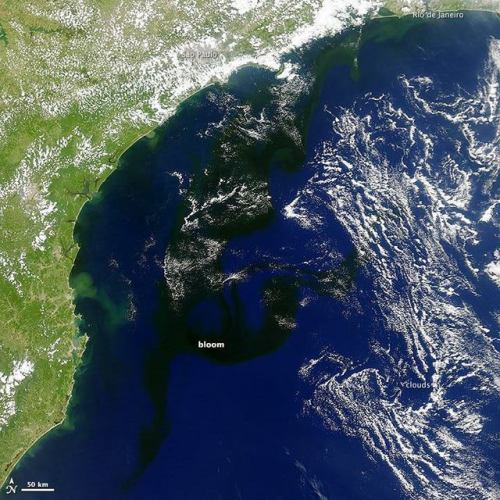
Covering the oceans in darkness….
Phytoplankton blooms produce some fascinating textures in Earth’s oceans, and consequently we’ve shared images of them taken from orbit many times (http://tinyurl.com/qhzwbr9, http://tinyurl.com/pwasxol). This bloom, however is a bit different from the others – in this photo from NASA’s Aqua satellite, it looks, well, black.
Keep reading

An oceanic phytoplankton bloom in the South Atlantic Ocean. Phytoplankton blooms usually occur where cold water rushes up from the bottom of the ocean carrying nutrients to sunlit waters.
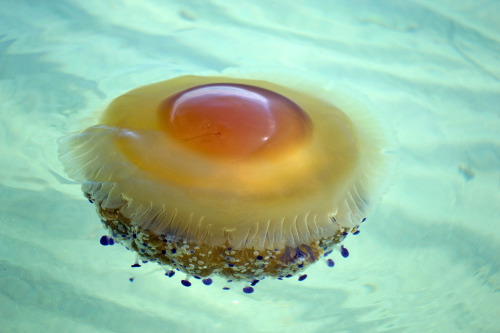

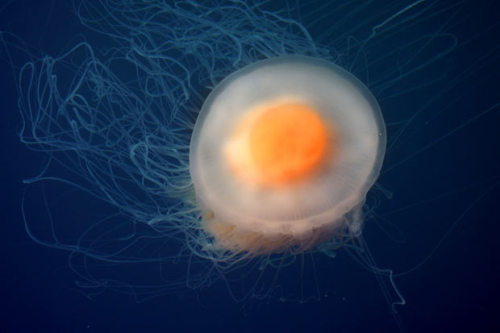
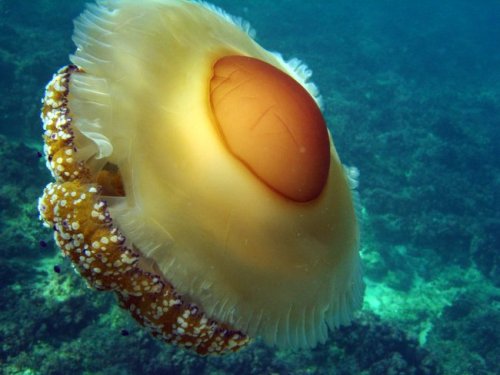
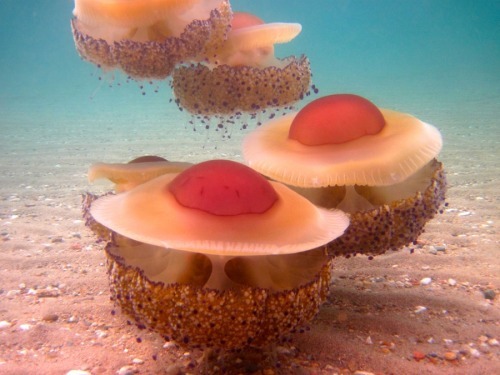
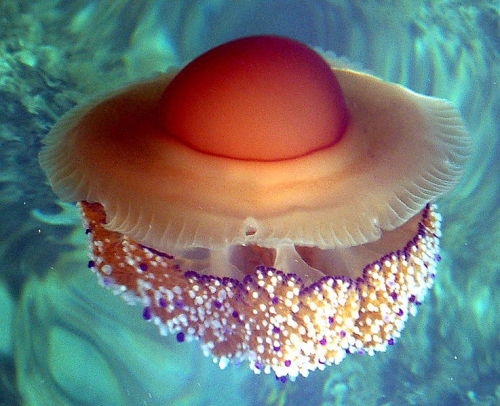
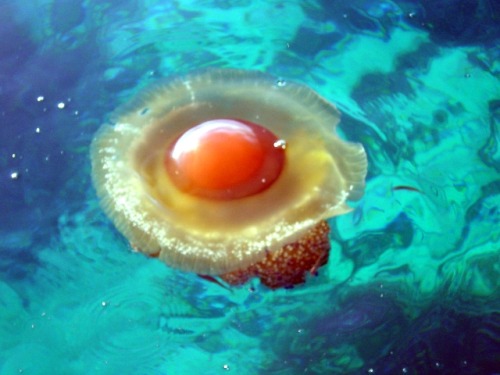
Fried Egg Jellyfish Are Kind of Adorable – & That’s No Yolk.
There are two species that hold the whimsical title of “Fried Egg Jellyfish”: Phacellophora camtschatica and Cotylorhiza tuberculata though the two are quite different from each other in all aspects beside appearance.
Phacellophora camtschatica is a huge jelly that prefers colder waters. It’s bell can reach up to 2 ft across and its dozens of tentacles reach over 20 ft long! If you don’t think this floating egg creature looks very menacing, you’d be right. It has a very weak sting and many small crustaceans take advantage of the jelly by riding on its bell (breakfast to go…?) while snatching up extra food.
Cotylorhiza tuberculata is a much smaller jellyfish that hangs out in warmer waters. It only reaches about 35 cm in diameter, so don’t go for this Fried Egg Jelly if you want a big breakfast. Unlike most jellyfish, C. tuberculata can swim on its own, without relying on the currents for movement. It’s sting (if you can even call it that) is so feeble that it has very little to no effect on humans at all. I mean, it does look like a breakfast food, after all… how powerful could it be?

“I make sure that when I am boating that nothing goes into the water, I try to recycle everything I can, and I don’t eat seafood unless it is invasive lionfish. I also participate in as many coastal cleanups to help to remove all of the garbage along our shorelines and I try to encourage others to do the same. We have a long ways to go in ocean conservation, but national marine sanctuaries, along with national parks, monuments, and wildlife refuges, afford us the best opportunity to help leverage limited resources to address coastal and marine conservation."
– Mark Chiappone, research associate at Nova Southeastern University and assistant professor at Miami Dade College
What inspires you about the ocean?
(Photo: Scrawled filefish in Florida Keys National Marine Sanctuary. Credit: Daryl Duda)

Recently, NASA Goddard released a visualization of aerosols in the Atlantic region. The simulation uses real data from satellite imagery taken between August and October 2017 to seed a simulation of atmospheric physics. The color scales in the visualization show concentrations of three major aerosol particles: smoke (gray), sea salt (blue), and dust (brown). One of the interesting outcomes of the simulation is a visualization of the fall Atlantic hurricane season. The high winds from hurricanes help pick up sea salt from the ocean surface and throw it high in the atmosphere, making the hurricanes visible here. Fires in the western United States provide most of the smoke aerosols, whereas dust comes mostly from the Sahara. Tiny aerosol particles serve as a major nucleation source for water droplets, affecting both cloud formation and rainfall. With simulations like these, scientists hope to better understand how aerosols move in the atmosphere and how they affect our weather. (Image credit: NASA Goddard Research Center, source; submitted by Paul vdB)
With Stephen Hawking’s passing, today is a sad day for science. But amongst all his praise and achievements in the fields of physics, for me personally his biggest achievement was making a grand, full life despite the terrible misfortune of being diagnosed with ALS. It would have been easy to become a recluse, embittered with the hand he’d been dealt, a brilliant misanthrope. But this was a man who maintained his sense of humor and refused to be mentally beaten. Three years ago, he told One Direction fans that the theory of alternate universes could provide a reality where Zayn Malik was still in the band. He conducted an interview with John Oliver where his factual, deadpan delivery was funnier than his interviewer, managing the cheekiest grins as he did so. And let us not forget that Stephen Hawking is the only person to have ever portrayed themselves in a Star Trek episode (Next Generation, “Descent, Part 1″), where he appeared alongside actors portraying Einstein and Sir Isaac Newton, whom he proceeded to defeat in poker.

Hawking’s observations on black hole radiation, string theory, alternate universes and artificial intelligence are things that will probably forever remain beyond most of us. But we could all learn a thing or two from his humanity.

Phot by Jero Prieto
-
 bbbubbleboyzzz liked this · 4 months ago
bbbubbleboyzzz liked this · 4 months ago -
 saberlord liked this · 3 years ago
saberlord liked this · 3 years ago -
 homosexualkrill reblogged this · 3 years ago
homosexualkrill reblogged this · 3 years ago -
 shmegel liked this · 3 years ago
shmegel liked this · 3 years ago -
 kyumiterasu liked this · 4 years ago
kyumiterasu liked this · 4 years ago -
 vampiricbloodyraven liked this · 4 years ago
vampiricbloodyraven liked this · 4 years ago -
 moved-5844 liked this · 4 years ago
moved-5844 liked this · 4 years ago -
 cernunnos1990 reblogged this · 4 years ago
cernunnos1990 reblogged this · 4 years ago -
 cernunnos1990 liked this · 4 years ago
cernunnos1990 liked this · 4 years ago -
 girldraki liked this · 4 years ago
girldraki liked this · 4 years ago -
 abluebottle liked this · 4 years ago
abluebottle liked this · 4 years ago -
 natto-axolotl liked this · 4 years ago
natto-axolotl liked this · 4 years ago -
 tao-armada liked this · 5 years ago
tao-armada liked this · 5 years ago -
 szialazerpunkvagyok liked this · 5 years ago
szialazerpunkvagyok liked this · 5 years ago -
 moonshadow0 reblogged this · 5 years ago
moonshadow0 reblogged this · 5 years ago -
 wrasse72 liked this · 5 years ago
wrasse72 liked this · 5 years ago -
 i-am-fibsh reblogged this · 5 years ago
i-am-fibsh reblogged this · 5 years ago -
 tupeloshoney liked this · 5 years ago
tupeloshoney liked this · 5 years ago -
 aikenarrows reblogged this · 5 years ago
aikenarrows reblogged this · 5 years ago -
 aikenarrows liked this · 5 years ago
aikenarrows liked this · 5 years ago -
 sluttykirby liked this · 5 years ago
sluttykirby liked this · 5 years ago -
 godlikebees liked this · 6 years ago
godlikebees liked this · 6 years ago -
 apeshit liked this · 6 years ago
apeshit liked this · 6 years ago -
 weoflittlefaith liked this · 6 years ago
weoflittlefaith liked this · 6 years ago -
 bbrrraaappp liked this · 6 years ago
bbrrraaappp liked this · 6 years ago -
 prismatic-eclipse liked this · 6 years ago
prismatic-eclipse liked this · 6 years ago -
 pearly--rose liked this · 6 years ago
pearly--rose liked this · 6 years ago -
 marinersubmariner reblogged this · 6 years ago
marinersubmariner reblogged this · 6 years ago -
 vidbjorn liked this · 6 years ago
vidbjorn liked this · 6 years ago -
 sonnetimo reblogged this · 6 years ago
sonnetimo reblogged this · 6 years ago -
 yampulp liked this · 6 years ago
yampulp liked this · 6 years ago -
 askgaina-akaseapancake liked this · 6 years ago
askgaina-akaseapancake liked this · 6 years ago -
 deepsea reblogged this · 6 years ago
deepsea reblogged this · 6 years ago -
 oyasumi-yunyun liked this · 7 years ago
oyasumi-yunyun liked this · 7 years ago -
 aglobeinthedark liked this · 7 years ago
aglobeinthedark liked this · 7 years ago -
 amightydirge liked this · 7 years ago
amightydirge liked this · 7 years ago -
 coolyo294 reblogged this · 7 years ago
coolyo294 reblogged this · 7 years ago -
 korrathevampireslayer3791 liked this · 7 years ago
korrathevampireslayer3791 liked this · 7 years ago -
 purposeofmymind reblogged this · 7 years ago
purposeofmymind reblogged this · 7 years ago

Blog dedicted to phytoplankton. Phytoplankton are microscopic organisms that are responsible for half of the photosynthesis that occurs on Earth. Oh, and they look like art... Follow to learn more about these amazing litter critters! Caution: Will share other ocean science posts!Run by an oceanographer and phytoplankton expert. Currently a postdoctoral researcher.Profile image: False Colored SEM image of Emiliania huxleyi, a coccolithophore, and the subject of my doctoral work. Credit: Steve Gschmeissner/ Science Photo Library/ Getty ImagesHeader image: Satellite image of a phytoplankton bloom off the Alaskan Coast, in the Chukchi SeaCredit: NASA image by Norman Kuring/NASA's Ocean Color Web https://earthobservatory.nasa.gov/images/92412/churning-in-the-chukchi-sea
158 posts